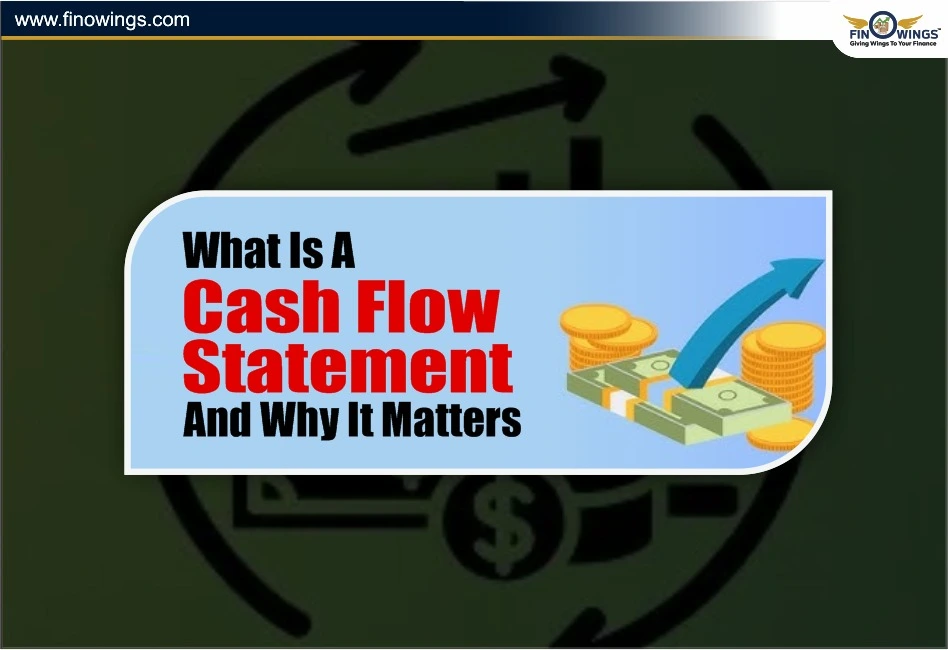Home >> Blog >> What Is a Cash Flow Statement and Why It Matters
What Is a Cash Flow Statement and Why It Matters

Table of Contents
Quite a lot of investors would look at the profit and loss statement or balance sheets when it comes to determining the financial health of a company. However the key pulse of any business is its cash flow statement. It unveils the actual flow of money in and out of a business, whether it will be able to endure, develop and continue its functioning.
This blog will describe what happens to the cash flow statement, why it matters, how to interpret it using examples, and how cash flow forecasting or cash flow projection makes planning for the future easier for businesses.
What Is a Cash Flow Statement?
A cash flow statement is an accounting report that captures inflows and outflows of cash over a particular time. It displays the ways a firm earns and uses cash by performing three functions, which are operating, investing, and financing.
Cash flow also captures a more accurate picture of liquidity because it always reflects real cash flows rather than theoretical cash flows like profit (which may include things that are not cash, such as depreciation).
Cash Flow Statement Definition:
A financial report reflecting the aggregate of cash and cash-equivalent receivables and payments of the business operation over a period to determine the liquidity, solvency and financial capabilities.
Why Cash Flow Matters
Knowing what is cash flow statement is assists individual investors and business owners to have an idea of whether a business is capable of producing enough cash to maintain itself and grow.
Even successful enterprises may collapse when they have no money left to meet their bills and other suppliers and employees. This is why analysis of cash flow is very crucial, as it points at the actual financial heartbeat of the business.
Components of Cash Flow Statement
A cash flow statement includes components that form the basis of the statement.
The statement of cash flow will consist of three large parts:
1. Operating Activities
This part presents cash that comes about as a result of the main area of the shared business which is selling the products or services.
Examples include:
-
Cash To receive Cash received from customers.
-
Money disbursement to suppliers or employees.
-
Income taxes paid
Positive working cash flow = business operations are healthy.
2. Investing Activities
This is a manifestation of the investment of the company in assets or other ventures.
Examples:
-
Buying or selling of property, equipment or securities.
-
The investments in joint ventures or subsidiaries.
The existence of a negative investing cash flow does not necessarily indicate a bad company that is experiencing growth.
3. Financing Activities
This segment follows cash flow between the business and its investors/ lenders.
Examples:
-
Borrowing or repaying loans.
-
Issues or purchases of shares back.
-
Paying dividends.
Positive financing cash flow: the money is being raised; negative financing cash flow: the money is being paid back or paid to the shareholders.
Cash Flow Statement Example
The following is the simplified example of the cash flow statement of ABC Ltd in FY 2024:
|
Activity |
Cash Flow (₹ Crore) |
|
Operating Cash Flow |
+250 |
|
Investing Cash Flow |
-120 |
|
Financing Cash Flow |
-80 |
|
Net Cash Flow |
+50 |
Interpretation:
Key highlights of the company show that it made 250 crore under its core business, used 120 crore in new assets, and paid 80 crore in debt.
A positive net cash flow of 50 crore means that the financial status is stable and the business can exploit the opportunity.
Cash flow projection and cash flow forecast: This function will help the company anticipate its cash income and cash outflows including both future and present years.
Cash flow projections and cash flow forecast:
The feature will enable the company to project its cash revenues and cash expenditures in both the future and present years. A cash flow forecasting (or cash flow projection) is a forecast of future cash inflows and outflows. It assists the management in short term planning of liquidity and long term funding requirements.
Cash Flow Forecasting Benefits:
-
Foresees future cash deficits or cash surpluses.
-
Assists in establishing budgets and financial objectives.
-
Helps to make decisions regarding investment, debt and expansion.
-
Prevents borrowing in the nick of time or risk of insolvency.
Example:
When a company estimates that 20 lakh is to be spent every month, and predicts that only 15 lakh worth of cash is expected to flow towards the company, it understands that it has to make up or cut down on its expenses before it runs out of funds.
Importance Of Cash Flow Statement.
The value of the cash flow statement is much higher than accounting it is crucial to strategic management, investors, and lenders.
1. Measures Liquidity and Solvency
It indicates the business has sufficient cash to cover the short-term liabilities.
2. Helps in Financial Planning
Existing cash trends show the past, which by examining the trend and estimating the cash flow forecast realistically, helps companies to prevent funding crises.
3. Assesses Business Health
Good operating cash flow indicates good fundamentals, despite the alteration in profits.
4. Directs the investment and lending decisions.
Before committing money to investments, investors and banks make use of cash flow information to determine the risk.
5. Identifies Accounting abnormalities.
A company having an unprofitable cash flow can be earnings management - another warning to an investor.
Key Ratios Derived from Cash Flow
Operating Cash Flow Ratio = Operating Cash Flow/ Current Liabilities
→ Determines the liquidity strength.
Free Cash Flow (FCF) = Operating Cash Flow - Capital Expenditures.
→ Shows the amount of cash that can be used to pay dividends, growth or debt.
You may also read our comprehensive article on Financial Ratios and Their Importance in Business Analysis to learn how ratios like the Operating Cash Flow Ratio and Free Cash Flow relate to more general financial analysis.
Tips for Reading a Cash Flow Statement
These are some of the tips when one is reading a Cash Flow Statement.
1. Find uniformity - positive cash flows that are sustainable make optimal sense.
2. Compare to net profit - a huge variance may indicate accounting aberrations.
3. Watch capital expenditures - an increase in capital expenditure can be indicative of expansion or excess.
4. Follow the financing streamlines of the business operations of the company - constant borrowing could be stressful to the cash flow.
5. Check cash reserves trend - decreasing reserves can indicate the possibility of liquidity risk.
Final Thoughts
It is important to know what is cash flow statement not only because accountants need to know such but also everyone who wants to make good financial or investment choices. Although, the balance sheet represents what you own, the income statement represents what you earn, the cash flow statement represents what you can spend.
Thus, be it a business, a stock, or personal finances, cash flow projection reading and provision can ensure that you are ahead of the game, as things are always liquid, grow, and you will stay solvent.
DISCLAIMER: This blog is NOT any buy or sell recommendation. No investment or trading advice is given. The content is purely for educational and information purposes only. Always consult your eligible financial advisor for investment-related decisions.
Author
Frequently Asked Questions
A cash flow statement shows how much money comes into a business and how much goes out. It helps you understand whether a company has enough cash to run its daily operations, grow, and pay its bills.
Cash flow reflects real money a company has on hand, while profit can include non-cash items like depreciation. A company may show profit but still run out of cash, which can lead to financial trouble.
A cash flow statement includes:
-
Operating Cash Flow: Money from core business activities
-
Investing Cash Flow: Money spent on or earned from assets
-
Financing Cash Flow: Money borrowed, repaid, or paid to shareholders
Each section explains a different part of the company’s financial life.
Cash flow forecasting (or projection) estimates future cash coming in and cash going out. It helps businesses plan expenses, avoid cash shortages, and make better decisions about investments and debt.
A company has good cash flow when:
-
Operating cash flow is consistently positive
-
Free cash flow grows over time
-
Cash reserves increase
-
Borrowing is under control
-
Cash flow matches or supports profit
These signs show the business is financially strong and sustainable.


















